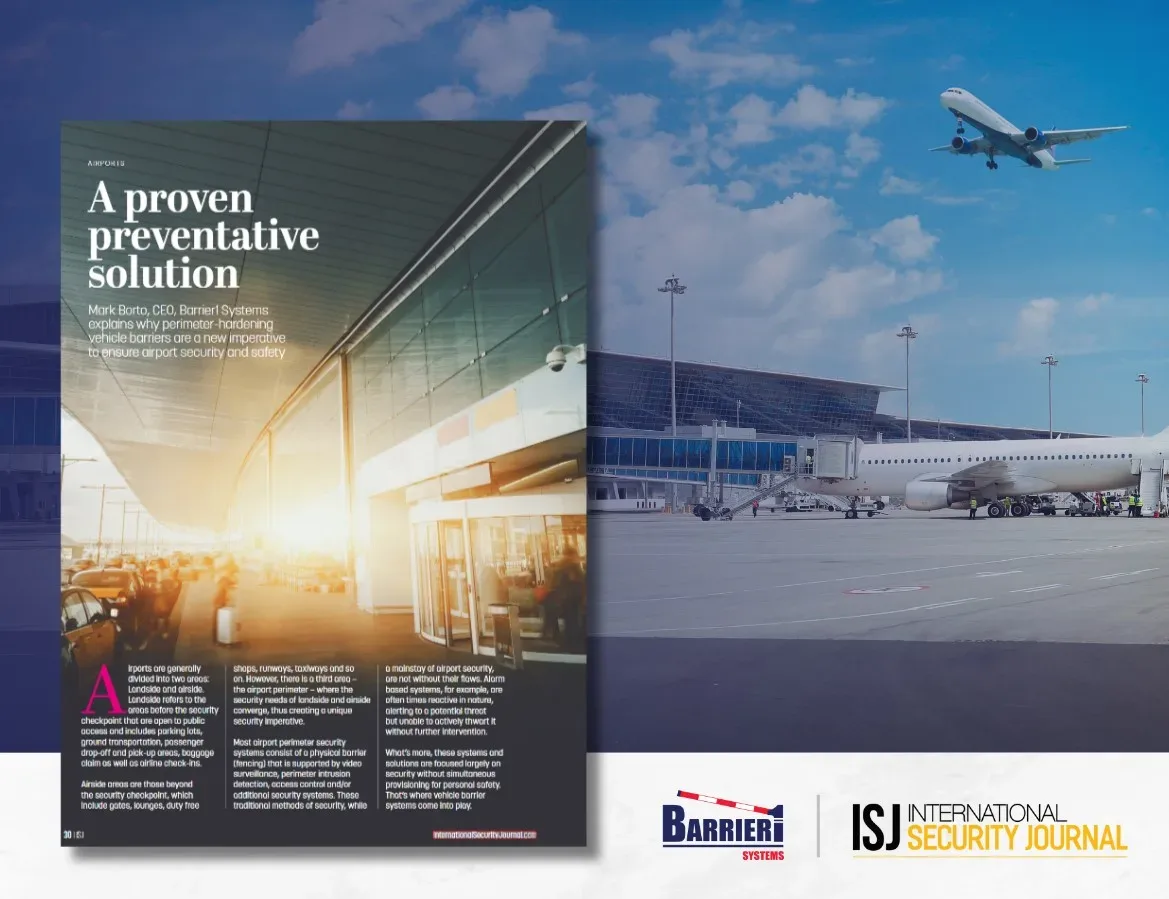
The Airport Perimeter Security Solution
You Can't Afford to Be Without
Mark Borto, CEO of Barrier1 Systems Explains Why Perimeter-Hardening Vehicle Barriers are a New Imperative for Airport Security and Safety
Airports are generally divided into two areas: landside and airside. Landside refers to the areas before the security checkpoint that are open to public access and include parking lots, ground transportation, passenger drop-off and pick-up areas, baggage claim, and airline check-in. Airside areas are those beyond the security checkpoint and include gates, lounges, duty-free shops, runways, taxiways, and so on.
But there is a third area, the airport perimeter, where the security needs of landside and airside converge, creating a unique security imperative.
Most airport perimeter security systems consist of a physical barrier (fencing) that is supported by video surveillance, perimeter intrusion detection, access control, and/or additional security systems. These traditional methods of security, while a mainstay of airport security, are not without their flaws. Alarm based systems, for example, are reactive in nature, alerting to a potential threat but unable to actively thwart it without further intervention. What’s more, these systems and solutions are focused largely on security without simultaneous provisioning for personal safety.
That’s where vehicle barrier systems come into play.
Vehicle barrier systems cater to the unique safety and security requirements of an airport’s perimeter by providing a proactive solution to vehicle intrusion or ramming incidents. Vehicle ramming is an often-overlooked threat that affects airports both landside and airside. And, unfortunately, they are not uncommon.
At Germany’s Cologne-Bonn Airport, a man injured five people when he allegedly intentionally drove a van into several pedestrians inside one of the airport’s parking garages. At the nearby Hamburg Airport, an 18-hour armed standoff began when a man drove through a gate onto the airport’s tarmac and parked near a plane. Across the globe at the Seattle-Tacoma International Airport, a car drove up on the sidewalk at the airport’s Upper Departure area, leaving a 4-year-old girl in critical condition and injuring two more. According to a spokesperson from the airport, the driver accidentally accelerated their vehicle causing the crash.
The incidents outlined above all occurred in 2023 and serve to highlight the various causes and effects of vehicle ramming incidents.
Many vehicle ramming incidents occur accidentally, caused by a medical emergency or operator error. An unintentional accident is especially likely to cause damage at landside airport areas where passengers arrive and depart. Here, a simple pedal error, or the act of pressing the accelerator pedal instead of the brake pedal while attempting to park or slow down, is common as drivers are in a rush to drop off or pick up loved ones. In these high stress environments, reactive electronic physical security systems may detect and capture such events but cannot prevent such accidents from causing physical or bodily harm and the costly ensuing liabilities.
Conversely, high-security bollards offer brute force protection against all types of vehicle ramming incidents. Crash-rated bollards undergo rigorous testing and are rated by standards set by the American Society for Testing and Materials (ASTM) to ensure their effectiveness under various conditions. Unlike a repurposed steel pipe filled with concrete, crash-rated bollards are purpose built to create a secure perimeter for airports, providing a clear distinction from the street and curb to protect the personal safety of those behind them. Bollards also prove themselves as an invaluable tool for traffic management, even adding to an airport’s aesthetics with a variety of types, designs, and colors available.
Airside, it is critical to consider the level of perimeter protection provided in the event of an intentional vehicle ramming incident. Whether motivated by terrorism or some other form of intentional criminal motivation, an individual may use a vehicle to deliberately cause bodily harm, gain unauthorized access to an airstrip, or carry out other malicious activities. They do this often by driving through an existing airport entrance where low-cost fencing and traditional gates are unable to stop a vehicle traveling at a high rate of speed.
This is why installing crash-rated beam and drop arm vehicle barrier systems is crucial to enhance security, and mitigate the risks associated with intentional vehicle ramming incidents. These solutions are capable of stopping a 15,000-pound truck traveling at 50 mph with minimal penetration. Drop arm systems with fast electronic operation are notably ideal for airport delivery and auxiliary entrances, where authorized entry is frequently required. In fact, many drop arm systems come with a surface set design, enabling fast setup and avoiding underground utilities. In this way, airports the world over can quickly improve security and minimize the potential dangers posed by intentional vehicle ramming incidents or unauthorized vehicle intrusions.
Whether it be intentional or accidental, the effects of vehicle crashes have an equally devastating effect. Personal injury and loss of life caused by vehicle ramming incidents threatens innocent airport travelers, visitors, employees, and contracted workers. Failure to secure the airport perimeter, both landside and airside, leaves these individuals open to unimaginable risk. Moreover, every such incident that makes headlines only fuels concerns over air travel safety on the ground.
Also consider the aforementioned incident wherein a vehicle drove through an airport gate and engaged in an 18-hour standoff with officers on the tarmac. Not only was this event dangerous and alarming, it halted air traffic at one of Germany’s busiest airports. The resulting lost revenue and inconvenience to passengers can likely be estimated in the hundreds of thousands, if not millions, when accounting for lost services, reparations, reputational damages, etc. The combined tangible and intangible costs should be seriously considered when determining if vehicle barrier solutions are a necessary part of airport security.
As air travel finally reaches and seems to be on-track to exceed pre-pandemic levels, there is a renewed focus on global safety at airports. And in this focus, it is important to evaluate both airport security and airport safety. Not just for landside and airside operations, but at the perimeter. In this way, crash-rated vehicle barrier systems offer a proven preventive solution. One that offers holistic airport protection against a very real and potentially devastating threat that is clearly preventable.
Please visit Barrier1.com for more information on crash-rated vehicle barrier systems.


